Menus
- Mini Swiss Army Knife
- Formerly confined to radical machines entirely dedicated to driving pleasure, MV Agusta with its Stradale 800 is venturing into the touring segment for the first time. The result is exciting if not perfect !
- Introduction
- Discovery
- IN THE SADDLE: Typed big SM
- IN THE CITY: Not bad at all
- HIGHWAY AND FAST TRACKS: Touring not GT
- DEPARTMENTAL: In its element
- BRAKING: at the top !
- DUO AND PRACTICAL ASPECTS
- Consumption
- Conclusion
Mini Swiss Army Knife
Formerly confined to radical machines entirely dedicated to driving pleasure, MV Agusta with its Stradale 800 is venturing into the touring segment for the first time. The result is exciting if not perfect !
Introduction
Before talking to you about the Stradale 800, I need to describe MV Agusta’s new global strategy. It can be summed up in one word: "expansion"! In 2013, the “Ferrari of the motorcycle” sold 7,500 machines. Its objective is to increase this figure to 14,000 by 2016. Please note, MV does not intend to compete with Yamaha’s MT 07 and MT 09.,
"We do not want to go downmarket by offering more affordable machines than at present" insists Giovanni Castiglioni, current CEO of MV Agusta.
It would even be rather the opposite since MV is out of stock on its RR models despite sales prices for the less salty … Expect to see MV Agusta even more Premium than currently. At the same time, MV is tackling categories from which it is currently absent, such as the very popular Touring machines. On its own, this segment could, depending on the brand, increase its registrations by 55%! This will obviously involve an expanded range of 16 to 26 models on the eve of 2018 and the introduction of a brand new 4-cylinder, currently under development. Another good news for fans of the brand, MV Agusta has (finally) understood that to sustain its activity, manufacturing beautiful machines is not enough. Attracting customers is good, keeping them is even better! Huge in-depth work on quality control, after-sales service and the distribution network was therefore launched at the start of the year. For France, the Italian recently created a dedicated structure, MV Agusta France, and recruited an experienced man in the person of Remy Hasser. Successively passed to BMW Motorrad, Ford, Triumph and Ducati, he has the heavy task of restructuring (cleaning up?) The national network. These details being made, let’s move on to the Stradale 800.
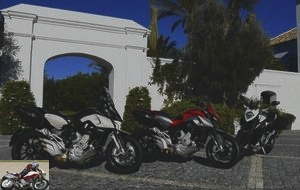
Discovery
The recent MV versions around the three-cylinder approach the concept of a common platform dear to the automotive world. The Stradale is not for all that a machine manufactured at the discount, on which one would have been satisfied to graft a large handlebars and a small nose screen, on the contrary. Without watering down the mechanical DNA of the brand, this MV is less extreme, more versatile and even, let’s not be afraid of words, usable on a daily basis. It goes through a chassis equipped with suspensions with long travel (150 mm) with triple adjustment (compression rebound preload), a more open caster angle (22.5 °) and an extended wheelbase via a longer swingarm (607 mm). The handlebars have been raised to improve comfort on long journeys and the screen above the dashboard can be adjusted by 5 cm in height and 5 ° in inclination. The new tank can also hold 16 liters of fuel.
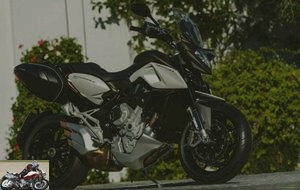
On the tire side, we have the right as original equipment to Pirelli Diablo Rosso II or Scorpion Trail in 120/70 – 17 and 180/55 – 17. The three right cylinders also have some modifications: new hydraulic clutch for a smoother action , increased exhaust volume (+ 2.8 L) to optimize torque in intermediate speeds reduce the noise level, gearbox 6 reworked for more smoothness … The Stradale also has four specific engine maps. Sport (115 hp at 11,000 rpm), normal and Rain (90 hp) favoring filling at half-speed and a customizable Custom mode. Why a Custom mode? Because each of these 4 modes also changes all electronic devices. We can thus act on the torque curve, the entry into action of the switch (Hard or Soft), the sensitivity of the throttle (3 positions), the engine brake (2 levels) and traction control (8 levels including an off mode). Let’s not forget either the new EAS 2.0 quickshifter which works up AND down gears without activating the clutch..
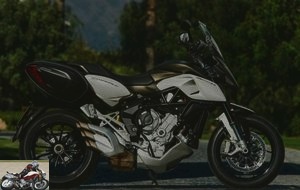
All these parameters can be changed via stems attached to the handlebars. Finally, MV Agusta specifies that the tank is equipped with a “proportional” sensor in the tank to offer a more precise reading of the level offering a “constant descent” of the gauge. Vocation tourism obliges, the Stradale is equipped with semi-rigid side bags. As they obscure the brake lights of the Stradale, MV has fitted them with additional lights to overcome this drawback (see the “duo and practical aspects” section). The Stradale is available in three color combinations: the traditional red / silver typical of the brand, white / gray and bronze / white.

IN THE SADDLE: Typed big SM
The finish of the MV Agusta has often been the subject of controversy: superb peripherals, high-quality paint and foundries rub shoulders with stickers without varnish, random adjustment of body panels and electrical circuit in spaghetti Bolognese version … Here, there is the best. The path of the wires is much less messy (even if it is still not perfect), the adjustments are precise and the whole is more serious (or less artisanal) than the first generations of three cylinders. On the other hand, we regret the sometimes coarse welds of the tubular mesh on several of our test models. Let’s put that on the pre-series and get on – or rather climb – in the saddle. First observation, you must have flexible adductors to pass your leg over the saddle without scratching the side cases. For the little ones, the solution is to first climb on the interior footrest to gain some centimeters before sitting on the promontory perched 870 mm from the ground. Once there, a pilot of 1.70 meters maintains the balance on the tips of the feet. Strongly the optional low saddle (850 mm) … As for the driving position, it is more typical (big) supermotard than trail with a low handlebars and close to the body. The footrests are low and in line with the body. Impossible not to think of a Ducati Hypermotard riding the MV, these two machines fight in the same category. The levers are adjustable to the millimeter, navigation in the dashboard interface is memorized in a few minutes. The backlit screen is readable if not ultra complete, with the exception of the tachometer.
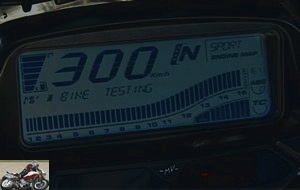
All that remains is to choose your mode before leaving. I opt for the standard (90 hp.) But the technical manager tells me that it is possible to change mode by driving with a simple pressure on the starter (engine running) and this even keeping the accelerator open unlike the competition. And unlike the competition, ABS can be permanently deactivated, even if the ignition is switched off..

IN THE CITY: Not bad at all
The exit from Malaga to reach the heights of the hinterland goes like a charm. The clutch is still a bit hard for intensive urban use, but the flexibility of the three cylinders and the smoothness of the gearbox make the experience very livable. Do not rely too much on the Quickshift II under these conditions. Admittedly, it is very efficient, even in intermediate speeds, but it only works from 30 km / h which prohibits its use in traffic jams. Another reason for satisfaction, the long-travel suspensions perfectly fulfill their function and gulp holes, bumps and other retarders without complaining. The direction is precise and the setting on the angle is done naturally. Even the turning radius (Italian style) is far from catastrophic. We are far from what a real supermotard can do but a U-turn on the departmental road is done without maneuvering or cold sweat.
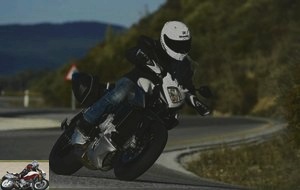
HIGHWAY AND FAST TRACKS: Touring not GT
The handlebar guards lack efficiency unlike the very efficient screen despite its small size in the high position. The air is deflected over the bottom of the chin bar and the top of the shoulders without generating aerodynamic turbulence or excessive noise. What cruising quietly at 150-160 km / h (in Germany) without forcing.
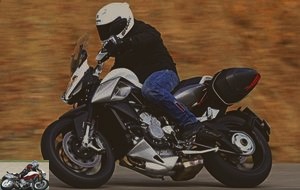
We would have liked to test the low position but the screws of our test models were so tight that no one was able to do the manipulation … The consistency of the saddle is incredibly soft by MV standards and not the least alert of harm to the foundation did not point the tip of his nose during our test of a little over 200 km. On the other hand, space is limited on the double-stage saddle which may prove to be problematic on long stages. Not only is mobility restricted but the hard foam triangle marking the separation between pilot and passenger is quickly annoying when you move back as far as possible.
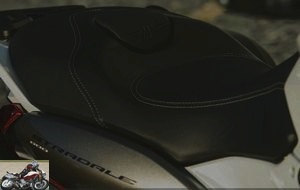
The Stradale is a GT, but not for the long haul. In any case, the carrying capacity of the side cases is too low to take more than the minimum essential for a romantic weekend. On the plus side, they have no influence on the Stradale’s high-speed stability, even at largely prohibited speeds. Legal-looking, the three-legged purrs at 5,500 rpm at 110 km / h and climbs up to 6,500 to 130 km / h. That’s good since this is the area where the fat of the torque is located, thus ensuring vigorous pick-ups without resorting to the gearbox to drop a report.
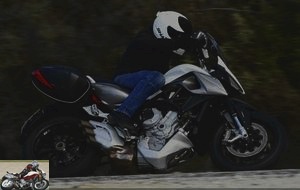
DEPARTMENTAL: In its element
If the Stradale is a machine dedicated to Touring, it is above all an MV. In the small roads overlooking the heights of Malaga, it displays excellent dynamic qualities. Lively, precise, light, it twirls from one turn to another without making its pilot sweat while offering a comfort of suspension hitherto unknown to the Italian brand. When entering a turn, the front end goes exactly where it is asked to go whether on momentum or on the brakes and when exiting the traction of the Diablo Rosso II has never been faulted, in the dry all at least. Here, everything is healthy, easy and we let ourselves be intoxicated by the charm of the three cylinders.
In normal mode (90 hp), he naturally pushes his pilot to ride on the fat of the couple, present in abundance from 5 to 9,000 rpm, when he instinctively pushes to change gear.
In Sport mode, it’s a whole different story, the threshold of 9000 revolutions corresponds here to the moment when the three legs find a second wind, rising with glee to the assault of the red zone (12,000 rpm) while changing voice, turning high with metallic accents to give goosebumps. One would almost come to regret that MV has slightly muffled the voice of his three cylinders to stick to his vocation of "toureuse".
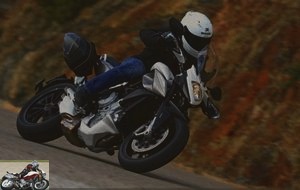
Note in passing that the management wanderings of the ride by wire of the first three cylinders are no longer a bad memory. The connection between accelerator and rear wheel is transparent here, whatever the mode chosen. The Quickshift II also greatly contributes to driving pleasure. Pleasant in the intermediate rhymes, it is stunningly efficient in the last third of the tachometer. The reports are mounted on the fly without breaking load and downshifts never destabilize the whole. Just cut the throttle and press the selector for the electronics to take care of the rest, putting the little bit of throttle in by automatically shifting the clutch to benefit from constant engine braking. You can be a “heel-to-toe” Ayatollah (I’m one of them), but you have to recognize a system that has the advantage of allowing you to forget this critical phase of driving in order to concentrate on the rest. Particularly effective when rolling at 80% of its capacity, the Stradale loses its splendor when it is abrupted a little too much. The very variable quality of the Spanish bitumen notably highlighted a small disagreement between front and rear suspensions as well as a too flexible hydraulic on the successions of bump. By slowing down the trigger at the rear, the Stradale regains some of its splendor, in particular by being more stable in the rapid changes of angles but it remains dependent on its trail / supermoto architecture. The high and flexible suspensions, the wheelbase which remains relatively short and the impossibility of loading the front end from the driving position mean that the Stradale is somewhat reluctant as soon as the mass transfers become caricatured. Except on billiards, a surprise braking on the angle tends to disunite the whole and cause some pumping of suspensions. Nothing serious or dangerous but the counterpart of the versatility and comfort of this MV Agusta is a sporty efficiency set back from its three-cylinder cousins of the brand…
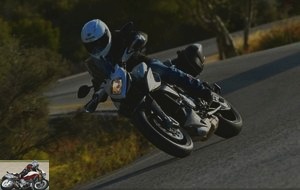
BRAKING: at the top !
At MV, we do not skimp on safety: double radial 4-piston disc signed Brembo at the front plucking 320 mm diameter wafers; single 220 mm disc and two-piston caliper at the rear, all under the control of a Bosch 9+ ABS incorporating an anti-stop system. The fans of too late panel braking will appreciate it, the stunters a little less but the ABS is disconnectable so you have the choice … On the pleasure side, it’s just perfect with feedback, power and endurance galore, all without premature triggering of the ABS at the front AND at the rear.

DUO AND PRACTICAL ASPECTS
Passenger space is limited but the seat foam is comfortable. The legs are not hindered too much by the suitcases but the footrests are anchored too high to consider long journeys with a sandbag measuring more than 1.70 m.
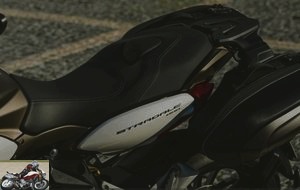
A word about the handling of the side cases. In addition to the presence of electrical connections to supply the integrated brake lights, the mounting system is complicated to say the least with, in addition to the key locking, a “quarter-turn” screw hidden in a small hole under the footrest plate. passenger. In short, to put down the suitcases, you need to have fairy fingers, good eyesight and, incidentally, a cloth since the place is particularly exposed to projections. Aware of the problem, MV Agusta assures us that he is looking into the question. To check if these famous screws will still be present when the Stradale arrives in concession. In terms of capacity, the side cases are far too small to contain a helmet but they can optionally be enhanced with a top-case, the only Touring option to date announced by MV Agusta.
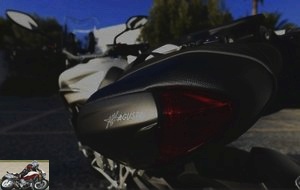
Consumption
During our test day, the average consumption displayed by the computer sailed between 7.8 L / 100km and 8.5 liters in nervous mode. We can therefore expect a total range of around 200 km in mixed use and a probable 250 km at stabilized speed on the motorway with the 16-liter tank. Not the panacea for a touring machine but no red card either…
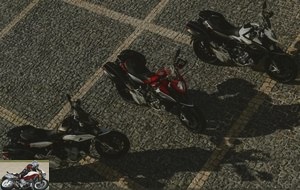
Conclusion
Giovanni Castiglioni describes his Stradale 800 as a Tourer Light. If we stick to this definition, this MV Agusta perfectly fulfills its objective. Versatile, charming, comfortable (especially for a MV), effective within the limits of the genre, it can rely on a particularly comprehensive technological package and perfectly developed to seduce. At least those who are looking for a machine with character that can be used every day. Some details need to be fine-tuned, such as the clutch, the autonomy and the tuning of the suspensions to make it a truly homogeneous machine, but the basis is healthy enough to attract a new clientele. In the micro-niche of Gtise supermotards type KTM 990 SMT (no longer present), the package offered by the Stradale is relevant, even at the price level with a sale price set at € 13,990, i.e. a price close to its rival the more direct, the Ducati 821 Hyperstrada, displayed at € 13,050. After those who are looking for a “real” machine to cut the road with weapons and luggage will have to either go their way or (perhaps) wait for the exit of the Turismo Veloce….
Strong points
- Versatility
- Comfort
- the bewitching three cylinder
- technology package-
Weak points
- Suspension agreement
- Some finishing details
- Autonomy a little tight
The technical sheet of the MV Agusta Stradale 800
Related articles
-
Without rival ? Known first for its F3 and F4 sports cars, MV Agusta has particularly developed its range since 2009, going from 3 to 11 models, notably…
-
The Italian exception lavishes strong sensations. Really strong ! 3 cylinders in line, 798 cm3, 140 hp at 12,300 rpm, 87 Nm at 10,100 rpm, 175 hp, €…
-
Test MV Agusta Turismo Veloce 800
The TGV (High Speed Tourism) according to MV Agusta A motorcycle completely redesigned for tourism and equipped with real saddlebags. MV Agusta…
-
Test MV Agusta Turismo Veloce 800 Lusso SCS
A very high-end and very techno vision of fast tourism 3 cylinders in line, 798 cm3, 110 hp at 10,150 rpm, 80 Nm at 7100 rpm, 192 kilos, € 21,490 Be…
-
Appeared in 2013, the 800 is the worthy heir to the 750 Brutale Oro, 4 cylinders, unveiled in 2000. For this new development which marks the transition…
-
MV Agusta Brutale 1000 Serie Oro test
0 to 100 km / h in 2.9 seconds! Muscular test at over 300 km / h ! 4 cylinders of 998 cm3, 208 hp and 115 Nm, 186 kg dry, 300 copies, 42,990 euros At the…
-
MV Agusta Superveloce 800 motorcycle test
Neo-retro in the right tempo 3 cylinders of 798 cm3, 148 hp, 88 Nm, 173 kg, 20,300 euros Concept bike adapted in an ultra exclusive limited series, the…
-
Chic ticket Anxiously awaiting the arrival of the small 675, the Brutale 990 R is entry level at MV Agusta. Admittedly, this flagship of Italian industry…
-
MV Agusta Rush 1000 motorcycle test
0 to 100 km / h in 2.9 seconds! All in excess ! 4 cylinders in line, 998 cm3, 212 hp and 116.5 Nm, 186 kg dry, 300 copies, 34,000 euros The success of…
-
MV Agusta Brutale 1090 RR test
Shock ticket With 80 cm3 and 5 more horsepower than the 990 R, the “big brutal” is positioned at the top of the pyramid in the great family of roadsters….
Hi Herve.
Thank you for these remarks. However, we did not fault either ABS or traction control. Only the ignition cut-off time of the latter seems a bit long to us..
Regarding the consumption, everything depends on the rhythm. Our tests are often rapid. However, we were predicting a very probable 400 km with full piloting trip. Regarding the reserve, I did not reach it. Our machine refueled along the way. It is therefore our consumption measured at the pump that we use.
Good road.
After 3000 km, completely satisfied with my purchase. Limit for my small size, 1.64m, stationary maneuvers remain cautious, but from 10km / h reached more problems. Although we can read, I put it without problem on its central. A tip in town especially in duo, leaving the suspension in solo mode, it saves a few precious centimeters (even with the low saddle option). On the road, think about readjusting the suspension and it is only happiness, only the wireless accelerator system did not convince me. The braking seems to me sufficient since the beast is not bought to do odd races, the ease in bluffing curve, the very appreciable torque, the autonomy> 400 km, and details that I qualified as uninteresting are proving to be pleasant. in use. Returning from a boring motorway ride goes better with the 130 km / h bubble regulator in the high position and the radio on (the better you plug in an iphone pad stuff … and the sound is perfect). For my wife after the ST then GT sprints which made her envy her friends’ BMWs, the trophy is now at the top of the question in passenger comfort, not to mention the heated saddle option that she uses regularly. To be continued with time and kilometers (I remind you of the revision every 16000km)
I agree with the content of your essay, which I read quickly, except on one essential point: the engine; having briefly tried during the JNMM the Indian Classic then the Springfield and finally the Gunner and having as a point of comparison (in recent Harleys) sweats the 1202 Low rider and the Fatbob my modest point of view is as follows:
The Gunner has noticeably more gusto at very low revs than the Indians, which is essential for the pleasure provided by the couple; in addition, it has much more reach. But, Indian or Victory, we end up with engines infinitely more alive and brilliant than the 102 (?) Fat Bob stage 0 ;; I am not talking about the 1202 which only distills a deep boredom; In short, the 106 ci is "linear" because it is brilliant from very low revs and it takes turns; in short, we can say that it is good everywhere, which is rare! Indian 111 and rounder all the way down and takes fewer turns but still a treat; in all cases, the HD is completely dropped in terms of sensations. Considering the modest investment it requires, this Gunner has an incomparable price / pleasure ratio for me (who am not a Customs customer but who knew how to appreciate them when they deserve it).